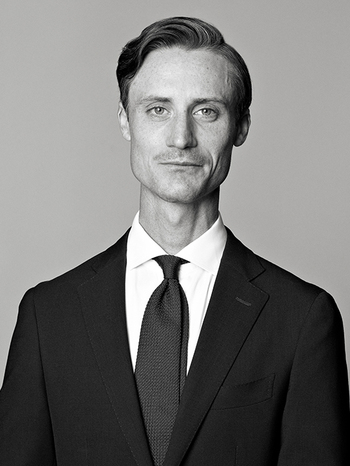Hilma af Klint
Still life
Signed H. af Klint and dated -86. Oil on canvas 90 x 69 cm.
Provenance
The industrialist Gunnar W Andersson (1889 - 1960), Skagerholm Manor, Sweden.
Vår Gård, Saltsjöbaden, gifted from the above.
Bengt Ekroth, gifted from Vår Gård (Kooperativa förbundet) in gratitude for long and faithful service.
Thence by descent within the family.
Literature
Kurt Almqvist and Daniel Birnbaum (ed.), "Hilma af Klint, Catalogue Raisonné", vol. 7, 2022, illustrated p. 43.
More information
Hilma af Klint's current painting from 1886 offers a rich and fascinating insight into her early, realistic painting before she transitioned to her abstract style. The work, depicting a wilting bouquet rendered in muted tones, is a masterful demonstration of the technical training she received at the Royal Academy of Fine Arts, while also carrying the symbolic undertones that would later permeate her art. The wilting of the flowers can be seen as a visual metaphor for the transience of life, where the cycles of nature reflect af Klint's existential musings on life and death, transience and rebirth – thoughts that would also become central to her later abstract works.
The painting can be viewed as a still life, a classic genre in painting often used to symbolise the passage of time and the fragility of life. Af Klint distinguishes herself here from her contemporaries, as she avoids the idealised flower still lifes that were popular in the 1880s, where artists arranged flowers from different seasons in illusionistic compositions to create an impression of abundance and beauty. Instead, she chooses to depict a wilting bouquet in muted colour tones, which imparts a quiet melancholy to the painting and reflects an early interest in the deeper philosophical and spiritual themes that are now characteristic of af Klint's artistic practice.
During her years of study at the Academy between 1882 and 1888, af Klint developed a solid technical foundation and impressive versatility. She mastered genres such as landscape and portrait painting as well as botanical studies, and even received awards for her anatomical drawings. Despite her significant contribution to the development of abstract art, she chose throughout her life to return to these figurative subjects and techniques, which were always marked by a sense of atmosphere and symbolic depth. While many Swedish artists at this time travelled to Paris to seek inspiration and discover the French artist colonies, af Klint chose to explore the Nordic region's own rugged landscapes, muted colour palettes, and dramatic atmospheres.
The auction's current painting showcases Hilma af Klint's impressive artistic breadth. They demonstrate how she was able to shift between illusionistically detailed works and symbolically charged forms – a spectrum that helped to establish her place as an early and groundbreaking pioneer in art history. Through this diverse artistic journey, af Klint laid the foundation for a practice that not only redefined her own time but also challenged the boundaries of art for generations to come.
Artist
Hilma af Klint (1862-1944) was a Swedish painter, theosophist and pioneer within abstract painting, and already in 1906 had created an abstract visual language. This was several years before Wassily Kandinsky, Piet Mondrian and Kazimir Malevitj who are still considered the forerunners of abstract art in the 20th century. Klint began her artist training at the Technical School in Stockholm (now Konstfack), where she also took lessons in portrait painting. After her studies, Klint acquired her own studio by Kungsträdgården where she painted and exhibited landscapes in naturalistic styles.
It was during a trip to Switzerland where she met Rudolf Steiner and was taken by his anthroposophical ideas and thereafter developed a strong interest for the occult. During séances, she received messages, which she transformed into abstract paintings. In 1986 Klint showed her abstract work for the first time in the exhibition, ‘The Spiritual in Art’, Abstract painting 1890-85, in Los Angelese. This exhibition came to be Hilma af Klint’s international breakthrough.
With a solo exhibition at the Modern Museum in Stockholm, Klint started a new phase of her artistic career. This became the most wrote about exhibition in the history of the Modern Museum and made Klint into a well-known name worldwide. Since 1972 her abstract work has been managed by the Hilma af Klint Foundation. The Modern Museum in Stockholm has a room dedicated to Hilma af Klint in their permanent exhibition, where the works shown are regularly rotated. She is even represented by the National Museum, the Royal Library, the Maritime Museum, the Nordic Museum and Uppsala’s University Library.















































